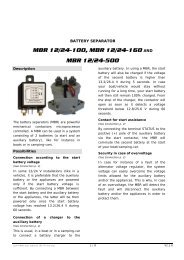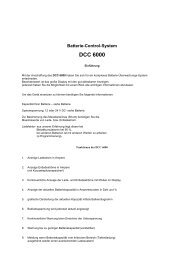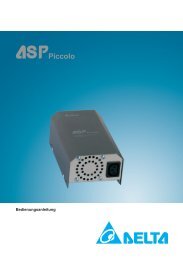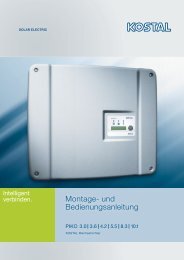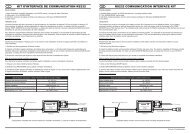StecaGrid 000+ Master/Slave StecaGrid 000+ Maître/Esclave - Axun
StecaGrid 000+ Master/Slave StecaGrid 000+ Maître/Esclave - Axun
StecaGrid 000+ Master/Slave StecaGrid 000+ Maître/Esclave - Axun
You also want an ePaper? Increase the reach of your titles
YUMPU automatically turns print PDFs into web optimized ePapers that Google loves.
3 Technical structure of the <strong>StecaGrid</strong><br />
3.1 General<br />
The <strong>StecaGrid</strong> is an inverter that uses a transformer to galvanically isolate solar<br />
modules from the mains grid, etc. The inverter was designed so that it can be<br />
installed outside without any problems (IP65).<br />
The <strong>StecaGrid</strong> is controlled by microcontrollers. The microcontrollers set the voltage<br />
of the solar modules in such a way that the solar modules provide their maximum<br />
output (maximum power point tracking). Both inputs have their own MPP<br />
tracker which allows you to design your system flexibly. For example, you can<br />
connect the modules with a south-east orientation to Input 1 and the modules<br />
with a south-west orientation to Input without any mismatches and therefore<br />
any loss in yield. Furthermore, it is possible to connect type-A modules to Input 1<br />
and type-B modules to Input without any mismatch occurring.<br />
The input voltage range was selected in such a way that the rated voltage range<br />
of the PV modules is covered from 80 V - 410 V (open circuit voltage max. 450<br />
V). The maximum input current that the inverter can process is 8 A per input.<br />
When both inverter inputs are connected in parallel the inverter can process currents<br />
up to 16 A. The MPP tracker ensures that the input currents never exceed<br />
the maximum permitted current.<br />
At night, the inverter keeps its use of the electronic components and electricity<br />
consumption to a minimum by switching to sleep mode. The inverter is protected<br />
against stand-alone operation.<br />
3.2 <strong>Master</strong>-slave principle<br />
The <strong>StecaGrid</strong> works according to the master-slave principle. With this principle,<br />
several functions are combined in the master (inverter A in the diagram).<br />
The inverters without these functions are referred to as slave inverters (inverters<br />
B and C in the diagram). The regional settings are made via the master.<br />
An MSD function is regulated for all the inverters via the master. The master<br />
also stores data from the master inverter and the slave inverters, etc. Because<br />
the functions are combined centrally, slave inverters can be realised more costeffective<br />
and more compact. <strong>StecaGrid</strong> <strong>Slave</strong> inverters can be connected to<br />
each <strong>StecaGrid</strong> <strong>Master</strong> inverter. Any type of <strong>StecaGrid</strong> <strong>Master</strong> inverter can be<br />
combined with any type of <strong>StecaGrid</strong> <strong>Slave</strong> inverter (a maximum of two slaves<br />
per master is possible). The combination of master and slave devices allows the<br />
dimensioning to be as flexible as possible: System sizes between 1600 Wp and<br />
7000 Wp are possible using master-slave combinations.* For system sizes greater<br />
than 7000 Wp several master-slave combinations can be used.<br />
* with a sizing ratio between 0.8 and 1. 5 and assuming that the system voltage and system current are within the<br />
operating range of the inverter.<br />
See www.stecasolar.com for a dimensioning software.<br />
3.3 Cooling<br />
The inverter transfers its heat via a cooling element. Because of the large surface<br />
area of the cooling profile the inverter can operate in ambient temperatures<br />
between – 5 °C and +60 °C.<br />
3<br />
WARNING<br />
Risk from hotness!<br />
�<br />
The surface temperature of the aluminium cover may exceed 70 °C.<br />
An integrated temperature control prevents excessive internal temperatures.<br />
When the ambient temperature exceeds the (derating) limit, the highest value<br />
of the power consumption from the PV modules is automatically adjusted to<br />
the prevailing temperatures. This process reduces the heat transfer from the<br />
inverter and prevents the operating temperature from becoming too high. When<br />
the ambient temperature is above +40 °C, maximum output can be restricted.<br />
<strong>StecaGrid</strong> inverters do without a ventilator for cooling and are therefore particularly<br />
low-maintenance.<br />
EN<br />
7 6.439 | 10.04<br />
<strong>Master</strong><br />
X A B C<br />
X) Control unit<br />
A) Inverter A<br />
B) Inverter B<br />
C) Inverter C<br />
<strong>Slave</strong> <strong>Slave</strong>



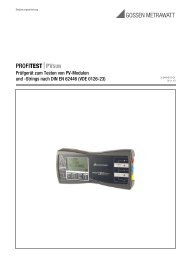
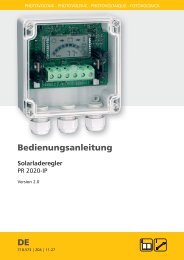
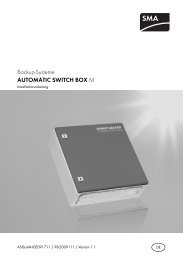

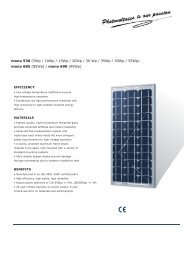
![SCHOTT PROTECT POLY 175-185 data sheet_D[...] - bk solar](https://img.yumpu.com/1309848/1/186x260/schott-protect-poly-175-185-data-sheet-d-bk-solar.jpg?quality=85)
